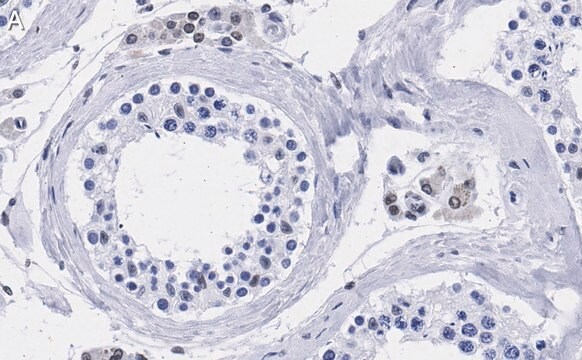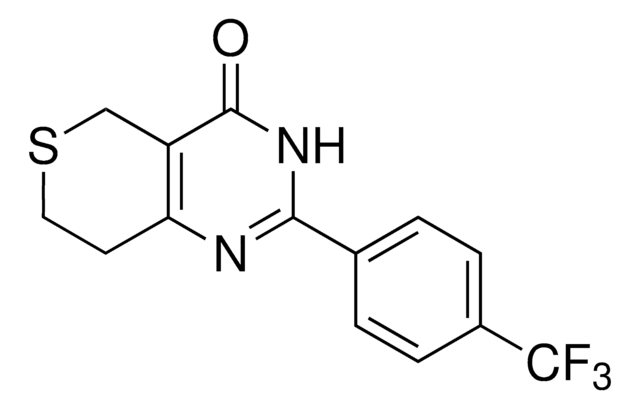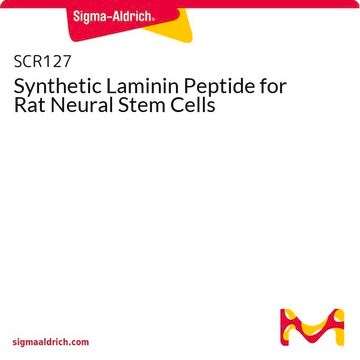추천 제품
생물학적 소스
rabbit
Quality Level
항체 형태
affinity isolated antibody
항체 생산 유형
primary antibodies
클론
polyclonal
정제법
affinity chromatography
종 반응성
mouse, human
기술
immunocytochemistry: suitable
western blot: suitable
NCBI 수납 번호
UniProt 수납 번호
배송 상태
ambient
타겟 번역 후 변형
unmodified
유전자 정보
human ... TFE3(7030)
일반 설명
Transcription factor E3 (UniProt P19532; also known as bHLHe33, Class E basic helix-loop-helix protein 33, TFE3) is encoded by the TFE3 (also known as BHLHE33) gene (Gene ID 7030) in human. TFE3 contains adjacent helix-loop-helix (HLH) and leucine zipper (LZ) domains flanked by an upstream basic region. It specifically recognizes and binds E-box sequences (5′-CANNTG-3′). TFE3 is ubiquitously expressed and can directly associate with DNA as either homodimers or heterodimers formed with two related proteins, TFEB or TFEC. In association with TFEB, TFE3 activates the expression of CD40L in T-cells, thereby playing a role in T-cell-dependent antibody responses in activated CD4+ T-cells and in thymus-dependent humoral immunity. TFE3 binds to and activates the microE3 motif of the immunoglobulin heavy-chain enhancer to induce B-cell-specific gene transcription and DNA recombination. TFEB is expressed at low levels in the embryo, but is expressed at high levels in the trophoblast cells of the placenta, where it plays a critical role in regulating normal vascularization. It has been shown that the exit from pluripotency is gated by intracellular redistribution of TFE3. Chromosomal aberrations involving TFE3 have been reported in patients with papillary renal cell carcinoma. Ref.: Betschinger, J., et al. (2013). Cell 153, 335-347.
특이성
This polyclonal antibody targets the human TFE3 leucine zipper region sequence.
면역원
KLH-conjugated linear peptide corresponding to a leucine zipper region sequence of human TFE3.
애플리케이션
Anti-TFE3, Cat. No. ABE1400, is a highly specific rabbit polyclonal antibody that targets transcription factor E3 (TFE3) and has been tested in Immunocytochemistry and Western Blotting.
Immunocytochemistry Analysis: A 1:500 dilution from a representative lot detected TFE3 in 4% paraformaldehyde-fixed, 0.5% Triton X-100-permeablized MEF-1 mouse embryonic fibrolasts.
Research Category
Epigenetics & Nuclear Function
Epigenetics & Nuclear Function
품질
Evaluated by Western Blotting in NIH/3T3 nuclear extract.
Western Blotting Analysis: 0.1 µg/mL of this antibody detected TFE3 in 10 µg of NIH/3T3 nuclear extract.
Western Blotting Analysis: 0.1 µg/mL of this antibody detected TFE3 in 10 µg of NIH/3T3 nuclear extract.
표적 설명
~75 kDa observed. Target band size appears larger than the calculated molecular weight of 61.52 kDa due to posttranslational modification. Uncharacterized bands may be observed in some lysate(s).
물리적 형태
Affinity purified.
Purified rabbit polyclonal antibody in buffer containing 0.1 M Tris-Glycine (pH 7.4), 150 mM NaCl with 0.05% sodium azide.
저장 및 안정성
Stable for 1 year at 2-8°C from date of receipt.
기타 정보
Concentration: Please refer to lot specific datasheet.
면책조항
Unless otherwise stated in our catalog or other company documentation accompanying the product(s), our products are intended for research use only and are not to be used for any other purpose, which includes but is not limited to, unauthorized commercial uses, in vitro diagnostic uses, ex vivo or in vivo therapeutic uses or any type of consumption or application to humans or animals.
적합한 제품을 찾을 수 없으신가요?
당사의 제품 선택기 도구.을(를) 시도해 보세요.
Storage Class Code
12 - Non Combustible Liquids
WGK
WGK 1
Flash Point (°F)
Not applicable
Flash Point (°C)
Not applicable
시험 성적서(COA)
제품의 로트/배치 번호를 입력하여 시험 성적서(COA)을 검색하십시오. 로트 및 배치 번호는 제품 라벨에 있는 ‘로트’ 또는 ‘배치’라는 용어 뒤에서 찾을 수 있습니다.
Kaushal Asrani et al.
The Journal of clinical investigation, 129(12), 5584-5599 (2019-09-19)
The microphthalmia family of transcription factors (MiT/TFEs) controls lysosomal biogenesis and is negatively regulated by the nutrient sensor mTORC1. However, the mechanisms by which cells with constitutive mTORC1 signaling maintain lysosomal catabolism remain to be elucidated. Using the murine epidermis
Kaiyuan Wu et al.
Autophagy, 17(11), 3707-3724 (2021-02-26)
The mechanisms orchestrating recycling of lysosomes through autophagic lysosome reformation (ALR) is incompletely understood. Previous data show that genetic depletion of BLOC1S1/GCN5L1/BORCS1 increases autolysosome (AL) accumulation. We postulated that this phenotype may manifest due to perturbed ALR. We explored this
자사의 과학자팀은 생명 과학, 재료 과학, 화학 합성, 크로마토그래피, 분석 및 기타 많은 영역을 포함한 모든 과학 분야에 경험이 있습니다..
고객지원팀으로 연락바랍니다.





